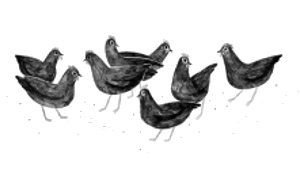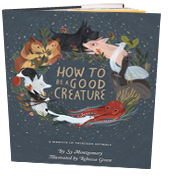How to Be a Good Creature: A Memoir in Thirteen Animals
by Sy Montgomery (author) and Rebecca Green (Illustrator)
Houghton Mifflin Harcourt (September 25, 2018), 978-0544938328
Chapter 1:
Molly: My First Mentor
As usual, when I was not in class at elementary school, we were together. Molly—our Scottish terrier — and I were doing sentinel duty on the spacious, crew-cut lawn of the General’s house, Quarters 225, Ft. Hamilton, Brooklyn, New York. Rather, Molly was keeping watch, and I was watching her.
Unfortunately for a Scotty, bred to hunt down foxes and badgers, far too little prey was to be found on the orderly and efficient Army base. Every inch was strictly manicured and wild animals were not tolerated. Still, because Molly did find the occasional squirrel to chase—and because, though we lived there, the home was not ours, but the Army’s, and we couldn’t put up a fence—she was chained to a sturdy, corkscrewing stake driven deep into the ground to keep her from running off. I watched her scan the area with her wet, black nose and her pricked, swiveling ears— longing, longing, as I did daily, to smell and hear, as she did, the invisible comings and goings of distant animals.
And then she was off like a furry cannonball.
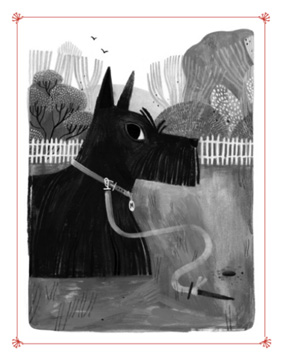 In an instant, she had ripped the foot-and-a-half-long stake from the ground and was dragging it and her chain behind her as she charged, snarling with gleeful fury, through the yew bushes in front of the brick, one-storey house. Quickly I glimpsed what she was chasing: a rabbit!
In an instant, she had ripped the foot-and-a-half-long stake from the ground and was dragging it and her chain behind her as she charged, snarling with gleeful fury, through the yew bushes in front of the brick, one-storey house. Quickly I glimpsed what she was chasing: a rabbit!
I leapt to my feet. I had never seen a wild rabbit before. Nobody had ever heard of a wild rabbit on Ft. Hamilton! I wanted a closer look. But Molly had chased the rabbit around to the front of the house, and my few, weak, second-grader’s feet, imprisoned in their patent leather Mary Janes, couldn’t carry me nearly as fast as her four, clawed, fully mature paws.
A Scottish terrier’s fierce, deep voice is too commanding to be ignored. Soon, out from our quarters came my mother and one of the enlisted men who had been assigned to help keep the General’s house tidy. A forest of legs exploded around me as the adults tried to zig-zag after the rabbit, trying to catch our furious terrier. But of course they couldn’t. By this time Molly had broken free of the chain and left the stake behind. There was no stopping her. Whether she caught the rabbit or not, she’d be out for hours, perhaps till after dark. She’d only come back, barking at the door to be let in with a single, summoning woof, when she was good and ready.
Though I wished I could have run after her, it wouldn’t have been to stop her. I wanted to go with her. I wanted to see the rabbit again. I wanted to learn the smells around the post at night. I wanted to meet other dogs and wrestle and chase them, to explore holes with my face, to discover treasures hidden in the dirt.
Many young girls worship their older sisters. I was no exception. But my older sister was a dog, and I—standing there helplessly in the frilly dress and lacey socks in which my mother had dressed me—wanted to be just like her: Fierce. Feral. Unstoppable.
***
I was never, my mother told me, a “normal” child.
As evidence, she cited the day my parents first took me to the zoo. I had just begun to walk, and, breaking free of my parents’ hands, toddled to my chosen destination: inside the pen housing some of the largest and most dangerous animals in the institution. The hippos must have gazed upon me benignly, rather than biting me in half, as these 3,000-pound animals are prone to do, or stepping on me. Because somehow, my parents got me out of there unscathed. My mother, however, never completely recovered from the incident.
I was always drawn to animals—far more than I was ever attracted to other children, or adult humans, or dolls. I preferred watching my two goldfish, Goldie and Blackie, and playing with my beloved but ill-fated turtle, Ms. Yellow Eyes. (My mother was from the south, and long before feminism, I learned from her the southern habit of bestowing on all females the honorific Ms.) Like most pet turtles in the 1950s, Ms. Yellow Eyes suffered from improper diet and died when her shell got soft. To console me, my mother gave me a baby doll, but I ignored it. When my father returned from a trip to South America and brought me back a stuffed baby caiman, a type of crocodile, I dressed it in the baby doll’s clothing and pushed it around in the doll’s pram.
An only child, I never yearned for siblings. I didn’t need other kids around. Most children were loud and wiggly. They wouldn’t stay still enough to watch a bumble bee. They ran and scattered the pigeons strutting on the sidewalk.
With rare exceptions, adult humans were not particularly memorable, either. I would stare blankly at an adult who I had seen many times, unable to place them, unless one of my parents could remind me of their pet. (E.g. “They’re the ones with Brandy.” Brandy was a miniature longhaired dachshund with red hair who loved to snuggle with me in my bed while the adults continued to enjoy their party after I was tucked in. I still can’t remember his people’s names or recall their faces.) One of the few pet-less humans I loved was my “uncle” Jack, not really an uncle, but a Colonel, a friend of my father, who would draw pictures of pinto ponies for me. I would carefully color in the spots while he and my father played chess.
When my language skills grew robust enough to discuss such matters, I had announced to my parents that I was really a horse. I galloped around the house neighing and tossing my head. My father agreed to call me “Pony.” But my elegant and socially ambitious mother, wishing that her little girl had the good sense to pretend she was a princess or a fairy, was worried. She feared that I was what people then called “retarded.”
The Army pediatrician assured her the pony phase would wear off. It did—but only when I disclosed that now, I was really a dog.
From my perspective, this presented only one problem. While my parents and their friends were eager to show me how to be a little girl, there was nobody around who could show me how to be a dog. Until I was three, and my short life’s ambition was realized with the arrival of Molly.
***
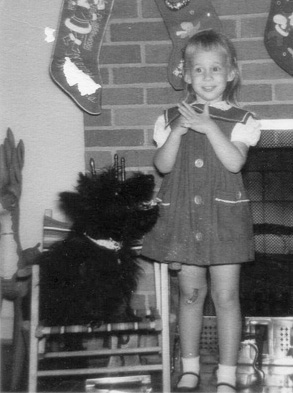 A Scottish terrier puppy is “bold and jaunty,” say breed websites, as well as notably “active and willful.” A Scottie’s characteristic traits of toughness and independence are evident even from infancy. An ancient breed concocted by thrifty Scots to keep vermin from bothering their livestock, these small, black dogs are Highland warriors. They’re strong and brave enough to outwit and subdue foxes and badgers, and smart enough to capably work independent of their owners. Though they’re only ten inches tall and weigh only about 20 pounds, Scotties “have all the compactness of a small dog and all the valor of a big one,” the critic and author Dorothy Parker wrote. “And,” she added, “they are so exceedingly sturdy that it is proverbial that the only fatal thing to them is being run over by an automobile—in which case, the car itself knows it has been in a fight.” A Scottie puppy is like a terrible two-year-old tot on steroids, combined with an almost unnatural indestructibility.
A Scottish terrier puppy is “bold and jaunty,” say breed websites, as well as notably “active and willful.” A Scottie’s characteristic traits of toughness and independence are evident even from infancy. An ancient breed concocted by thrifty Scots to keep vermin from bothering their livestock, these small, black dogs are Highland warriors. They’re strong and brave enough to outwit and subdue foxes and badgers, and smart enough to capably work independent of their owners. Though they’re only ten inches tall and weigh only about 20 pounds, Scotties “have all the compactness of a small dog and all the valor of a big one,” the critic and author Dorothy Parker wrote. “And,” she added, “they are so exceedingly sturdy that it is proverbial that the only fatal thing to them is being run over by an automobile—in which case, the car itself knows it has been in a fight.” A Scottie puppy is like a terrible two-year-old tot on steroids, combined with an almost unnatural indestructibility.
But although we shared a toddlerhood, tough, feisty little Molly was exactly my opposite.
Something bad happened to me at some point after I turned two, after my family moved back to the states from Germany, where I’d been born. In Germany, we’d had a nanny, but now I was my mother’s responsibility. My mother would later tell me that I contracted a very rare case of early childhood mononucleosis. But my father’s sister thought this was a lie, and indeed, many years later, I found no note of this diagnosis in my Army medical records. My aunt was convinced I had been smothered, shaken violently or both, probably repeatedly. Evidently I cried a lot. Even many years later, when I was a teenager, my mother was still complaining bitterly to her friends about how my crying had ruined her cocktail hour. Her evening martinis were the best part of her day. They must have eased her loneliness when my father was away, leaving her alone with a howling baby.
Whatever happened to me, for many months afterward, I wouldn’t play or talk. I refused to eat. I turned three, and still I hadn’t grown.
Naturally my condition must have distressed both my parents. My mother bought a little bowl with animals at the bottom, which I could only see only if I finished my cereal. She cut my toast into animal shapes with cookie cutters; my father tried to tempt me with milkshakes (into which he clandestinely slipped a raw egg.) Their desperation over my failing health may have been what prompted them to consider adopting a puppy.
Today, dog trainers and parenting coaches would have warned against it. Dog trainers agree that Scotties, while wonderful dogs, are not a good match for small children. Toddlers might step on toes or clutch at a tail, and Scotties won’t put up with this. They’re apt to bite, and their jaws and teeth are as big as an Airedale’s. Scotties are exceptionally loyal, but they are also considered the fiercest of the terriers. And today most experts caution against getting even the most docile and patient of dog breeds till a child is six or even eight.
But none of this deterred the glamorous Cuban émigrée who I knew as Aunt Grace from giving us one of her three precious puppies.
Aunt Grace was not really my aunt, and her husband, who I grew up calling Uncle Clyde, was not really my uncle. Uncle Clyde was my father’s best friend, but Aunt Grace was my mother’s rival. Aunt Grace wore her waist-length, jet black hair pinned into elaborate twists, custom-tailored dresses that featured plunging necklines and slit skirts, black eyeliner, crimson lipstick and high heels. My mother considered her a show-off. “What color dress you think Aunt Grace wore to the vet when she took the puppies in for their vaccinations?” she once asked me.
“Black?” I guessed. Personally, I would have wanted to look as similar as possible to the rest of the family. “No,” my mother corrected me—“white!” The puppies would show up better that way.
It must have been soon after that vet visit that Molly came to live with us. And though nothing in my short life could have possibly matched the glory of that day, alas—whether because of my illness or injury, or because I was just too young—any memory of that life-changing moment is lost to me.
But its effect was soon obvious.
Not long after she joined us, my parents took a black and white photo of Molly and me—one that my mother would later send as the family’s holiday greeting card the Christmas two months before I’d turn four. Though my short, puffy sleeves show the season is summer, Christmas stockings hang by the fireplace and a mechanical Santa doll stands beside me on the brick floor, ready to ring a brass bell. Like all my mother’s Christmas card compositions, it was a set-up shot. But Molly’s and my elated expressions are genuine.
***
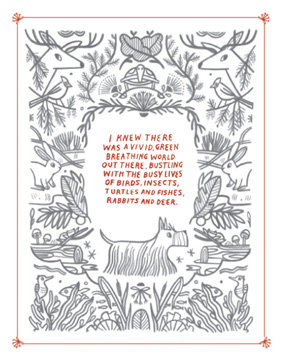 “Molly’s got a Daddy sock!”
“Molly’s got a Daddy sock!”
Like most puppies, Molly loved to steal, and she especially loved to seize my father’s black dress socks, the ones he wore to work with his General’s uniform. When Molly would steal them, far from tattling on her, I would eagerly announce to the household the spectacle that would follow. It always amused my dog-loving father. Having routed the sock from its usual lair, in the bedroom hamper, or sometimes from where it was hiding in the toe of a shoe, Molly would race into the living room, growling ferociously, and then proceed to shake the sock with single-minded, delighted fury. There was no getting the sock back until Molly was certain that she had finally broken its neck.
As a puppy, Molly didn’t chew things. She killed them. Sure, she liked rawhides and bones, but she was after something utterly different when she attacked my father’s socks. Though I can’t remember her ever actually slaying any animal, she imagined objects to be alive, and then imagined herself slaying them.
She loved to destroy balls. Small ones didn’t interest her. She didn’t fetch. With explosive intensity, she chased large, air-filled plastic spheres—soccer balls, kick balls, dodge balls—and she bested them all. I would walk her on leash from our quarters down to the Army post’s tennis courts early in the morning, before the adults would occupy the space, to roll one of these balls for her. With her deep-throated growls reverberating in my chest, I’d watch her tear across the clay surface of the court as the ball struggled to stay ahead of her nose. But she would always corner it; once she punctured its lungs with her long, white canines, the ball would deflate enough so she could get the entire thing in her strong jaws and shake it into oblivion. When it was dead she let me pick it up and examine it. The thing looked as if it had been punctured by ice picks. A small dog had done this with her face. I was impressed early on with the fact that Molly was a powerful being, worthy of deep respect.
Apparently others on the post recognized this, too. When Molly was older, after we gave up on the stake and chain, she would frequently go out at night alone. Folks on the post got to know her. On one of her nightly jaunts, she visited the Women’s Auxiliary Army Corps barracks. (Women were not integrated with the male Army until 1978.) A number of the women were outside that night, and word got back to us the next day that when they saw Molly trotting by, they stood in line, allowed her to sniff them, and then saluted her as she continued on her way.
The story could well be apocryphal. Or it could be the WAACs really saluted her, only because she was the General’s dog. It could also be that these strong, brave women saw and respected this little female dog’s independence and spunk. An earlier General had recognized this quality, too, in his Scotties. Commander of the Scottish Army Major General George Douglas, also known as the Earl of Dumbarton, had a pack of distinguished Scottish terriers in the 19th century, whom he nicknamed “the Diehards.” His Scotties inspired him to name, after them, his favorite Regiment, The Royal Scots, “Dumbarton’s Diehards.”
With typical Scotty self-reliance, Molly didn’t need people to tell her what to do. She wouldn’t come when we called her in at night. Eventually my parents figured out we could blink the front porch lights on and off to signal we would like her to come home. It was merely a suggestion—the way my father felt about traffic lights (he called a red light “just a suggestion”). Molly would come home when she felt like it.
This bothered me not at all. I certainly didn’t expect her to obey me. Why should she? By the time I was five, she was only two—but she, by then, was a full adult. I considered her not only my superior, but my role model. I did not even realize that my view of our relationship wasn’t endorsed by other humans—until my mother set out to tame us both.
***
The very characteristics that make Scotties special—independence and tenacity— also make them difficult to train. One trainer’s website noted that Scotties famous stubbornness and self-reliance “tend to make them think obedience is optional.”
Yet, incredibly, while our Molly was running loose and destroying toys and clothing, my glamorous Aunt Grace managed to train her Scotties to say their prayers and play the piano.
Aunt Grace had purchased a squat, black, child’s toy piano, like the kind Schroeder plays in the Peanuts cartoon. She would call Mac, Molly’s brother, into the living room. “Play the piano!” she would urge with great verve. The dog, sitting in front of the plastic keyboard, would mash first one set of keys, then another, alternating paws. I was also learning piano at the time and was impressed that Mac could play with both hands before I could.
Next Aunt Grace would impress her guests with her Scotties’ piety. A large, pale blue upholstered footstool would serve as their dinner table, set with two matching blue placemats ready to receive two dog dishes. While Aunt Grace held their two shiny aluminum bowls brimming with food, Mac and his mother, Ginny, would sit up, side by side. Aunt Grace set the bowls down. “Say your prayers!” she’d urge, and the Scotties would place their paws at the edge of the “dining table” in front of them, bow their heads, and tuck their snouts beneath their paws. They’d hold this position until Aunt Grace signaled it was time to eat.
This was impressive, and impressing one’s peers was very important in Army high society. My mother was no dog trainer—though as a child in Arkansas, she’d had a beloved little beagle-mix named Flip, who was tragically run over by a car—but she was a skilled seamstress. So she set out to best her glamorous rival. Our dog might not be able to perform like a person, but she could dress like one.
Though the Scottie’s hard, wiry coat was bred for weather-resistance, my mother began to sew little coats for Molly. She had coats for both summer and winter wear. A tartan plaid would have been nice, but my mother went for pastels—Molly was female, after all, and my mother felt she should dress the part. Then she turned her attention to Molly’s furniture. Mac had a piano in Aunt Grace’s living room. Molly would not be outdone. My mother bought a canopy bed for Molly, which was headquartered between the kitchen and the living room, for which she created covers, a pillow and of course a canopy in royal red satin, with ruffles all around.
My own dresses began to sprout more ruffles, too, as my mother tried, with increasing fervor, to make me at least look like the dainty little girl she’d always wanted. At the private school in Brooklyn, girls did not wear slacks, and in fact I didn’t own any jeans until we moved and I entered public school in 5th grade. I was strictly admonished not to get my clothes dirty, to the point that, in kindergarten, I’d refused to finger paint even with a smock on—a tale my mother recounted many years later with great pride.
At her featherweight black and gold Singer sewing machine, my mother created dress after pretty dress for me, often in fabric that would match one of her own. Her most dazzling achievement was the outfit she made for me for an elementary school play, in which I, because I was forever shorter than all the other kids in my class, played Little Bo Peep. The costume, all pink and white, with eyelet lace and an embroidered bonnet, was so spectacular that the audience gasped when I stepped on stage.
But as my mother valued girliness, I revered dogginess. I was entranced by Molly’s otherworldly powers. She could hear my father’s approaching staff car long before it arrived in the driveway. She could smell an opened can of Ken-L-Ration from the moment my mother took it out of the refrigerator. She could see in the dark.
Could I acquire such superpowers, I wondered? On TV, cartoon characters could walk through walls like Casper the Friendly Ghost and fly in rocket ships like on Space Angel. But here was a being who really did have more-than-human genius, and as a small child I pledged myself her acolyte.
No spot on her body eluded my fascinated scrutiny, from the sandy bumps on her long, pink tongue to the way her anus seemed to bloom when she hunched to defecate. I followed avidly every swivel and fold of her ears, every twitch and flare of her rubbery nose. Everything about Molly was perfect.
There were many differences between Molly and me, besides the most obvious ones. Her nostrils were shaped like commas. Mine were simple holes. Her ears were not just mobile, unlike my stationary ones, but inside them, I could see they housed mysterious, cartilaginous structures unlike my own. But these differences, I decided, were not insurmountable. Maybe I could still be like her. If only I could learn her doggy secrets! I remember spending hours lying on the floor, my head resting on my arm, inches from her face, watching her sleep, trying to absorb her scent, her breath, her dreams.
In my fantasies—elaborate daydreams I nurtured for years—Molly and I would run away from home together. We’d live in the woods. We’d lap water from clear streams. We’d find food in the forest, and shelter in a hollow tree. All the other animals would know us, and we would know them. We’d spend our days watching, sniffing, digging, exploring. She would teach me all about the world—the real world, outside the post, away from school, far from asphalt and brick and concrete. With her at my side, I could learn the secrets of wild animals.
Even though we lived on an Army base, and later in the tame suburbs, I knew there was a vivid, green, breathing world out there, bustling with the busy lives of birds and insects, turtles and fishes, rabbits and deer. I knew it from books and from TV shows like Wild Kingdom and Jacques Cousteau—but I believed it because Molly could hear it and smell it. The real world, the world I already loved, was just out of my ordinary human sensory range. For now. But one day, I knew, we’d escape and go there, to the wild places, where Molly would at last share with me her animal powers.
